Wood Splitting Made Easy: The Tire Trick
- February 21, 2024
- 2 comment
Finding ways to streamline the demanding task of wood splitting has always been a priority for me. The goal is to discover methods that make splitting wood not only more efficient but also easier on the body. Throughout my experience, I’ve experimented with a range of techniques, from using a traditional axe to employing mechanical log splitters.
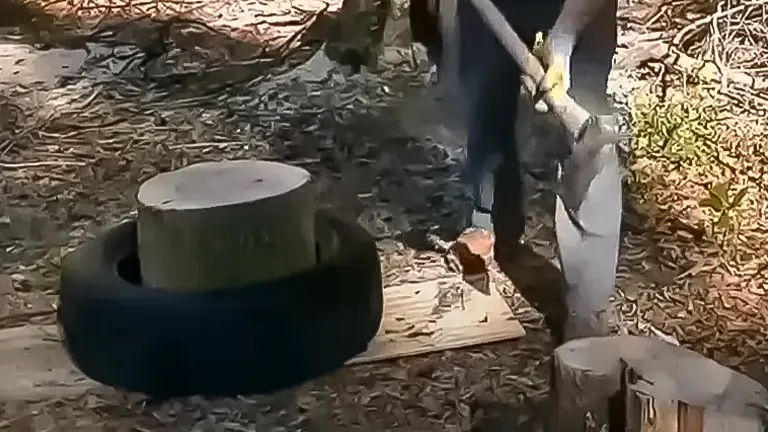
Recently, I came across a strategy that greatly eases the wood splitting process: the tire method. This article provides an in-depth look at my personal experience with this practical technique and introduces six other methods that have proven effective in making wood splitting more straightforward.
Table of Content List:
- The Tire Trick
- Using a Splitting Wedge
- The Bungee Cord Technique
- The Rope Wrap
- Lever Axe
- Mechanical Log Splitter
- The Kindling Cracker
The Tire Method
This approach utilizes an old tire to hold the log in place while splitting it. By securing the log inside the tire, it prevents the split pieces from scattering, which means you don’t have to constantly bend over to pick them up for further splitting. This method is particularly useful when dealing with logs that would typically require multiple splits, as it allows for the placement of several smaller pieces within the tire at once, thereby saving time and reducing physical strain.
Method 1. The Tire Trick
The premise of the tire trick is brilliantly simple yet incredibly effective. Instead of placing the log on the ground and swinging away with an axe, risking the split pieces falling all over the place, you secure the log within an old tire. This setup holds the log and its split pieces together, eliminating the need to constantly bend over and reposition them for further splitting.
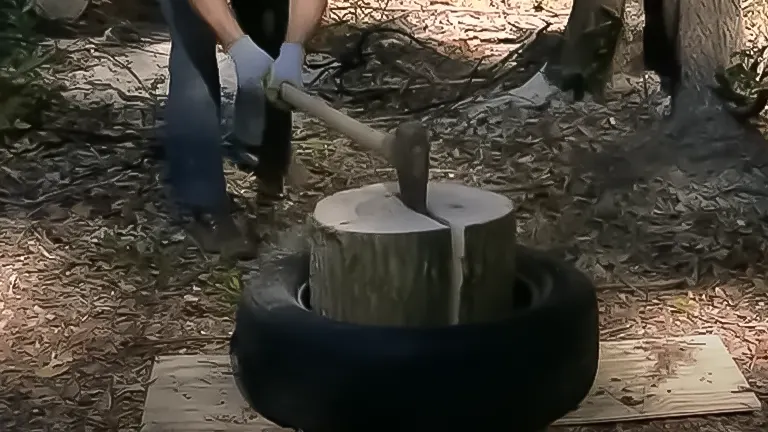
The efficiency of this method became evident when I was processing a particularly stubborn White Oak. The tire held the pieces together beautifully, allowing me to split multiple logs without the usual stop-and-go. For smaller pieces, I found that I could fit two or three logs within the tire, further speeding up the process. The tire trick is a game-changer, especially for those who process their firewood.
Method 2: Using a Splitting Wedge
Before the tire trick, one of my go-to methods was using a splitting wedge and sledgehammer. This method is particularly effective for larger, more difficult logs.
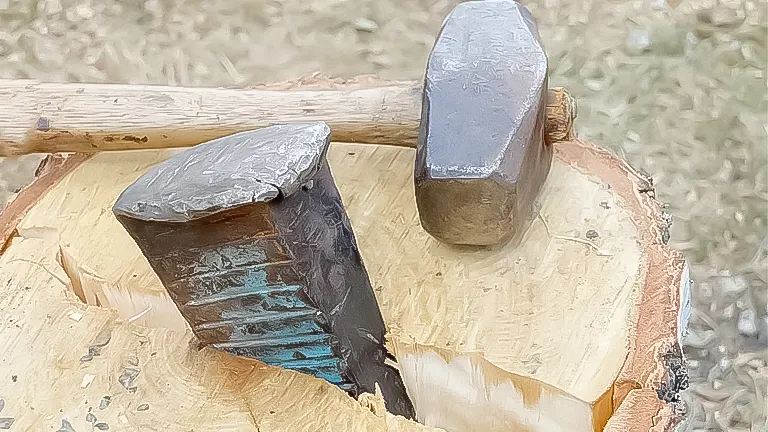
By driving the wedge into the wood with the sledgehammer, you can apply more force than with an axe alone, making it easier to split tough wood. This method requires a bit more equipment but is highly effective for challenging pieces.
Method 3: The Bungee Cord Technique
Similar to the tire trick, using a bungee cord to hold the log pieces together offers a way to maintain efficiency. After your initial split, wrap a bungee cord around the pieces to keep them upright and together.
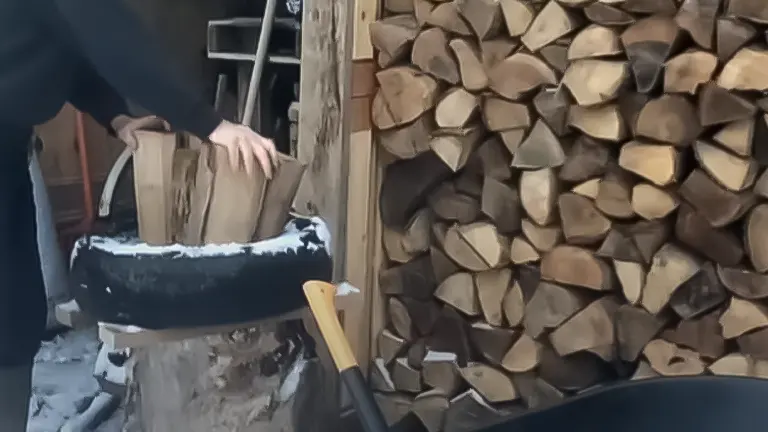
This method is a bit more flexible than the tire trick, as you can adjust the tension as needed, but it may not hold larger quantities of wood as securely.
Method 4: The Rope Wrap
For those without an old tire or bungee cords, using a sturdy rope can be a surprisingly effective alternative. After placing the log upright, wrap a rope around it several times and tie it securely.

Like the tire trick, this method prevents the split pieces from falling apart, allowing for continuous splitting with minimal repositioning.
Method 5: Lever Axe
The Lever Axe is a modern take on the traditional axe, designed to make splitting wood easier and safer. Its unique design allows for more efficient splitting, with less effort required per swing.

The first time I used it, I was amazed at how quickly I could get through a pile of logs. It’s a bit of an investment but worth considering for those who split wood regularly.
Method 6: Mechanical Log Splitter
For those looking to minimize physical labor, a mechanical log splitter is the way to go. Though it represents a significant upfront investment, the time and backache saved make it a worthy consideration. I’ve used both electric and gas-powered models and found them to be incredibly efficient, especially for larger volumes of wood.
Method 7: The Kindling Cracker
For making kindling, the Kindling Cracker is a safe and easy method. It’s essentially a metal frame with a built-in axe blade.
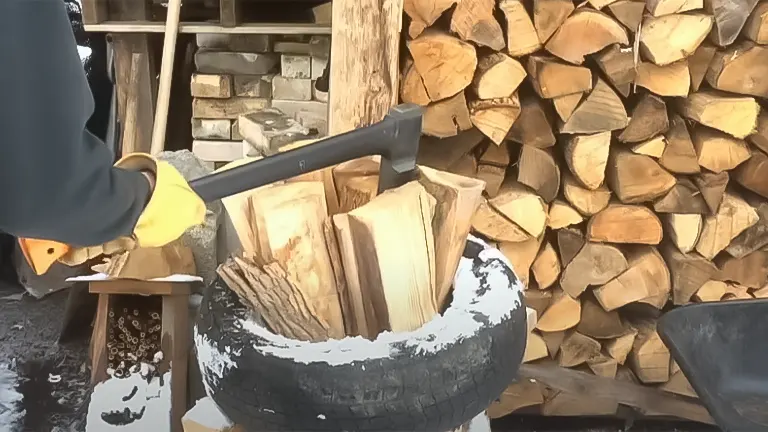
You simply place the wood on the blade and hit it with a hammer or another piece of wood. It’s safe, efficient, and perfect for getting those smaller pieces needed to start a fire.
Quantifiable Measurements of Performance
To evaluate the tire trick, I compared it against traditional methods across several performance categories:
- Efficiency: Traditional axe splitting without the tire resulted in an average of 30-40% time spent repositioning logs. With the tire, this dropped to virtually 0%, essentially boosting my splitting efficiency by over a third.
- Physical Strain: The reduction in bending and lifting when using the tire trick noticeably decreased back and shoulder strain, making it possible to split wood for longer periods without fatigue.
- Safety: Stability is key in wood splitting. The tire method minimizes the risk of logs slipping or flying pieces, offering a safer environment, especially for amateur woodworkers.
Pros and Cons
Pros
- Reduced Physical Strain: Significantly less bending and reaching, which is a boon for anyone with back issues.
- Increased Safety: The tire minimizes the risk of logs rolling or pieces flying unpredictably.
- Cost-effective: Utilizes an item that many would consider waste.
Cons
- Space Requirement: You need a dedicated space to set up the tire and log, which might be a constraint for some.
- Tire Sizing: Finding the right tire size for different logs can be a bit of a puzzle, especially for unusually large or small logs.
Final Conclusion
Each of these methods has its place depending on the volume of wood you’re splitting, the physical effort you’re willing to exert, and the tools you have at your disposal. For me, the tire trick stands out for its simplicity, cost-effectiveness, and efficiency.
It’s a low-tech solution that significantly reduces the physical strain of wood splitting and has changed the way I approach this task. Whether you’re a seasoned wood splitter or just starting out, incorporating some of these methods can make your wood-splitting process much easier and more enjoyable.
Frequently Asked Questions
- What is the tire trick for wood splitting?
The tire trick involves placing a tire around the log you intend to split. This setup holds the log in place and keeps the split pieces together, making the process more efficient by reducing the need to constantly bend over to pick up pieces for further splitting. - Why use a tire for splitting wood?
Using a tire streamlines the wood splitting process by keeping split pieces contained. This not only saves time but also minimizes physical strain, as it eliminates the need to reposition logs between splits. - How do I set up the tire for splitting wood?
Place an old tire on a stable, flat surface. Position the log upright inside the tire. Make sure the tire is snug enough to hold the log firmly. You can start splitting the log with your axe or splitter, and the tire will keep the pieces together. - Can I split multiple logs at once with the tire trick?
Yes, if the logs are small enough to fit within the tire, you can place two or three logs inside and split them simultaneously. This can significantly speed up the splitting process for smaller pieces of wood. - What type of tire should I use for wood splitting?
Any sturdy, old tire that can fit around your logs will work. Larger tires from trucks or SUVs are ideal for bigger logs, while smaller car tires can be used for average-sized logs. - Is the tire trick safe?
Yes, the tire trick is safe when done correctly. The tire helps stabilize the log, reducing the chance of the log moving unpredictably. However, standard safety precautions for wood splitting should still be followed, including wearing safety gear. - Can I use a bungee cord or rope instead of a tire?
While a tire is most effective for keeping split wood together, a bungee cord or rope can be used as an alternative to wrap around the log pieces. However, these may not offer the same level of stability and containment as a tire. - Does the tire trick work with all types of wood?
Yes, the tire trick is effective with various types of wood, including hardwoods and softwoods. However, the ease of splitting will still depend on the wood’s characteristics, such as grain pattern and moisture content. - How does the tire trick compare to mechanical log splitters?
The tire trick is a more cost-effective and portable solution compared to mechanical log splitters. While not as fast as mechanical splitters, it significantly improves the efficiency of manual splitting without the need for electricity or fuel. - Can the tire trick help with making kindling?
Yes, once you have split your logs into smaller pieces, you can further split these pieces into kindling while they are still contained within the tire. This method keeps the kindling organized and reduces the effort needed to handle small wood pieces.
We’re eager to hear your feedback! If you’ve tried the tire trick for wood splitting, please share your experiences and insights in the comments section below. Your personal stories and advice could greatly benefit others looking for efficient ways to split wood. Whether you found it helpful, have tips to enhance the method, or encountered challenges, your input can guide fellow woodworkers and enthusiasts in making well-informed decisions. Let’s build a community of shared knowledge and support each other in mastering wood splitting made easy!

Edward Smith
Forestry AuthorWoodworking is about more than crafting; it's a harmonious connection with nature, mastering tools, and preserving our environment. I'm here to share my knowledge and experiences with you, forging a future where we can embrace wood's beauty and utility while safeguarding our forests' health and diversity.
2 comments
Great article. I'll certainly be giving some of these ideas a try. Thanks













Top Mark's for the tyre trick, I'm going to set it up with a range of sizes to make it even more effective
Andy Robinson
February 24, 2024 3:09 pm